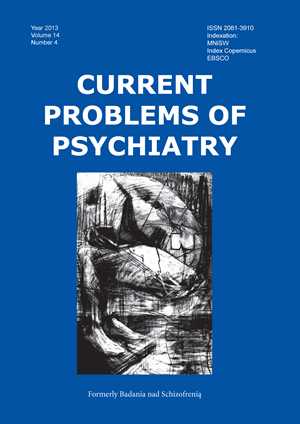Health and welfare situation of the disabled and their families in their natural residential environment
Keywords:
disability, adaptation to living with a disability, coping with disability, the family of the person with a disability, nursing homesAbstract
The aim of this study was to assess the health and welfare situation of the disabled and their families in their natural residential environment.
The study covered 199 persons with motor disability and their families. Ninentynine study participants lived in nursing homes, while 100 – in their family homes. The study was conducted using a diagnostic survey.
The disabled who lived in nursing homes were mainly single women from rural environments, with primary education; their health problems were related to the disorders of motor organs and nervous system. Most of them either had limited independence and needed occasional care or were fully dependent and needed twenty-four-hour care.
The surveyed disabled who lived in family homes came from urban environments and had secondary or university education. The welfare situation of the disabled living in family homes was positively affected by a high percentage of professionally active family members. Thanks to the support of their families, people with a limited independence that lived in family homes coped with their dis-ability and its psychological effects better than the disabled living in nursing homes.
References
1. Tomaszewski T. Psychologia. Warszawa; PWN: 1975.
2. Zabłocki J.K. Wprowadzenie do rewalidacji. Toruń; Wyd. Adam Marszałek: 1998.
3. Wilmowska-Pietruszyńska A. Niepełnosprawność. Orzecz. Lek., 2009; 6(2): 82-89.
4. Majewicz P. Obraz samego siebie a zachowanie młodzieży niepełnosprawnej ruchowo. Warszawa; CBRRON: 2002.
5. Kowalik Z. Psychospołeczne podstawy rehabilitacji osób niepełnosprawnych. Katowice; Wyd. Śląsk: 1999.
6. Sękowska Z. Pedagogika specjalna. Warszawa; Wyd. PWN: 1991.
7. Zimbardo P.G., Ruch F.L. Psychologia i Życie. Warszawa; PWN: 1994.
8. Sheridan C.L., Radmacher S.A. Psychologia zdrowia. Wyzwanie dla biomedycznego modelu zdrowia. Warszawa; Wyd. Instytut Psychologii Zdrowia: 1998.
9. Włodarczyk D. Wsparcie społeczne a radzenie sobie ze stresem u chorych po zawale serca. Przegl. Psychol., 1999; 4: 95-113.
10. Kawczyńska-Butrym Z. Wyzwania rodziny: zdrowie, choroba, niepełnosprawność, starość. Lubli; Wyd. UMCS: 2008.
11. Szczygielska-Majewska M i wsp. Wybrane problemy dotyczące niepełnosprawności. Ann. UMCS S. D. Medicina 2005; Vol. LX; SUPPL. XVI N. 5 295: 355-358.
12. Kawczyńska-Butrym Z. Rodziny osób niepełnosprawnych. Problemy wspierania rodzin z osobami niepełnosprawnymi. W: Ostrowska A. red., Badania nad niepełnosprawnością w Polsce 1993. Warszawa; IFiS PAN: 1994.
13. Sawicka M. Rodzice i dzieci chore na schizofrenię. W: Pisul E., Danielewicz D. red., Rodzina z dzieckiem z niepełnosprawnością. Gdańsk; DWP: 2007.
14. Witkowski T. Rozumieć problemy osób niepełnosprawnych. Warszawa; MDBO: 1993.
15. Ustawa z 27 sierpnia 1997 r. o rehabilitacji zawodowej i społecznej oraz zatrudnianiu osób niepełnosprawnych (Dz.U. z 2011 nr 127 poz. 721 Art. 3, 4 tekst obowiązuje od 1 kwietnia 2012 r.).
16. Ustawa z dnia 12 marca 2004 r. art. 16 Dz.U. z 2004 r. Art. 20 ust 7 z dnia 29 XI 1990 o pomocy społecznej.


